Text
Spooky Canon #694
Banette and Stufful absolutely love it when their trainers handle them like plushies, holding them under their arms, moving their arms around in conversations, etc.
Bewear on the other hand wants to hold their trainers and replicate the same actions that they enjoyed prior to evolving.
34 notes
·
View notes
Text
Delibird facts/PSA
While they're very generous and kind, you should never take more than one or two berries from wild Delibird during late fall and most of winter. This is because it’s during this time they’ll be taking care of their young, who are not yet capable of flying.
A Delibird first starts learning to fly in late winter at the soonest, so they rely on the food their parents get for them. But the generosity of a Delibird means they’ll give as many berries as they feel is needed and gets taken by those they come across. So if you end up interacting with a wild Delibird this season think about their young!
For this same reason you shouldn’t catch Delibird at this time of the year unless it’s the only way to save them.
27 notes
·
View notes
Text
Pokemon fact of the day
Audino have a substance in their saliva, audinic acid, that acts as a very effective antiseptic. Until this substance was successfully synthesised to create the first man-made antibiotic, audino spit was a common folk remedy for cuts and burns.
36 notes
·
View notes
Text
The Maushold Tales is a collection of Paldean folktales that were complied together about 500 years ago in writing but have been known in oral tradition for over 1000 years. Each story focuses on a specific lesson or moral, and involves pokemon as characters. The Maushold Tales are considered to be a literary classic, and are very popular to read to children.
108 notes
·
View notes
Text
Headcanon #483
Eevees can evolve into espeons and umbreons via social boding with their own kind, or with other species of pokemon. To evolve into sylveon, they specifically must bond with a human.
35 notes
·
View notes
Text
Headcanon #64
Evolutionary stones are used to evolve Eevee when it's not in the right environment for the Trainer's desired evolution. When evolved naturally, all Eevee evolve with friendship. This makes Eevee a rather key component to understanding Pokémon evolution since its evolution methods involve environment, friendship, and stones.
An Eevee with a high friendship, raised in an area that is frequented by thunderstorms will evolve into a Jolteon. However, the same Eevee can evolve into a different evolution with the use of a stone, regardless of friendship bonds.
Curiously, there are three branches of Eevee evolutions that cannot evolve with stones: Umbreon, Espeon, and Sylveon. These three evolutions in particular continue to mystify researchers as they try to understand the circumstances that causes Eevee to evolve into each of these, and how it defers from the environment standards of other Eevee evolutions. These are the only evolutions you might find mixed in with other evolutions in their environments.
20 notes
·
View notes
Text
the big bad eevee speculative biology post
i have been threatening to make this post for so long and now i'm doing it. exorbitant amount of eevee headcanons below the cut (there's pictures i prommy)

eevee is a small mammalian pokemon, and more specifically, a monotreme. (egg-laying mammal) it is omnivorous; feral eevee forage for berries and vegetables, and occasionally hunt small rodents and birds, whereas domestic eevee will eat almost anything they are given. you are unlikely to find eevee in the wild, as as a species, it is domesticated. (all pokemon are friendly and tameable, but eevee is like ACTUALLY domesticated. more on that later) feral populations do exist, but eevee often do not fare well in the wild due to being domesticated. the vast majority of the population are bred in captivity and kept as pets. because of their popularity as pets, they are found all over the world. they are easily recognized by their long ears, fluffy mane, and large tail. they come in varying shades of brown, and may or may not have white or brown markings anywhere on their body. some eevee have longer hair that can be styled by their trainer. male eevee have a jagged patch on their tail while female eevee have a round one.
eevee are friendly and social creatures, and not at all territorial. (though when they evolve, they can become more territorial. as such, proper training is crucial.) they are generally friendly to other eevee, humans, and other pokemon, provided they aren't treated with aggression or hostility. two eevee will often greet each other by sniffing the other to identify them, much like dogs. eevee will often try to greet other pokemon this way too, which sometimes results in confusion for both parties. they are diurnal; active during the day and asleep at night.
eevee are also fairly intelligent creatures. their intelligence could be sort of equated to a human four or five year old. they can understand basic human speech, such as their own name and commands from their trainer, and are good at recognizing human expressions. (just like dogs in real life!) eeveelutions tend to be a bit more clever and shrewd than their unevolved counterparts.
adult eeveelutions or eevee, like most pokemon, can breed and produce a small clutch of eggs. breeding eevee is difficult for inexperienced breeders, as members of the eevee family can only produce eggs about twice a year; a few days in the summer and a few days in the winter. successful breeding will result in a clutch of 1-5 brown and cream colored eggs being laid. at this point the mother becomes highly attentive to her eggs. nesting and incubating them becomes a full-time job for her and the father (if the father is part of the eevee family. behaviors of other pokemon vary)

eevee family mothers and fathers are highly aggressive towards any perceived danger towards their litter; yet another reason why breeders should be experienced before trying to raise eevee.
eevee eggs incubate for about three months, gradually growing in size until they finally hatch. i never really liked how pokemon just came out of their eggs more or less fully grown so i am simply choosing to reject it. <3 when eevee babies hatch, their physiology is noticably different from their fully grown form.

a newborn eevee hatches with cream colored hair, sometimes with faint brown mottling. their ears are short and floppy, and their hearing is poor at this stage. their eyes are completely closed at birth, and the only way they navigate is through smell and some hearing. they have no mane, and their tail is small. they cannot walk and are completely reliant on their mother for protection and milk.
shiny eevee merely skip the browning fur entirely and keep their baby coats. in fact, certain unreputable breeders will sell infant eevee at exorbitant prices, marketing them as "shiny eevee," when in reality it's just a normal baby. such practices are BAD, for more reasons than just swindling people, and any pokemon breeder worth their salt won't separate an eevee from their mother until about the ten week mark.

during this period, their hair starts to turn a light brown, though it's a far cry from their adult coloring. their eyes, which are blue at this stage, open up, but their eyesight is still poor. they can't quite walk, but at this point they're getting stronger, and can crawl around. the fur around their neck starts to grow long; it's the beginning of their mane. though they have developed considerably, they are still fully reliant on their mothers.

by this stage, a baby eevee is now sort of walking, toddling around, learning how to keep its balance and get around. its eyes are completely open and it can see just fine. the eyes are still blue at this point, but they're noticably getting darker as its adult color comes in. their mane is still growing, but now full enough that you could reasonably call it a mane. their ears are standing up more, and their tail will start getting bushier at this point. at around 6 to 8 weeks, they start weaning off of milk and begin eating some soft solid foods. at this point they'll also start making their recognizable cry, rather than just squeaking and mewling. a playful streak emerges as they become less helpless!
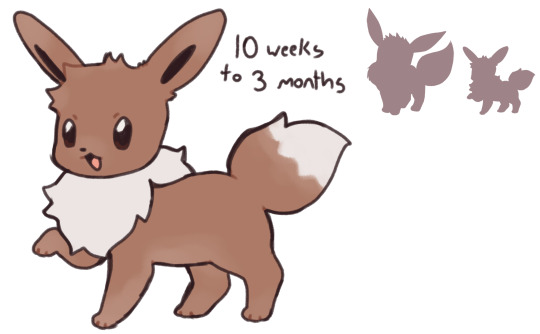
the most development happens in this month. their adult colors and mane are almost completely grown in, and their ears are fully standing now. their tail is still getting there, but it will bush out considerably as they approach the 3 month mark. an eevee of this age is completely weaned off of milk and eating solid food. they can walk and run, and by this point are learning how to be an eevee. they begin to become independent at this point, and the parent(s) become gradually less aggressive and defensive towards others, knowing that the baby is no longer a baby.
by about 1 year old they are just about fully grown, and become receptive to evolution stones and other evolution-inducing situations.
i can't think of a good transition here . i wanna talk about the domestication of ancient eevee
eevee and the eeveelutions are a direct result of domestication and human intervention. they've been domesticated for thousands of years, and have developed massive physical and mental changes as a result. the friendliness and overall docility of the species is one obvious example, but so is their cute appearance and even amount of evolutions.
paleontologists believe the wild ancestor of eevee was first domesticated tens of thousands of years ago, somewhere near ancient kanto. ancestral eevee had only one evolution, dubbed "eon." the type of eon is unknown and hotly debated by paleontologists and historians, but it was probably normal or ground type. it had aspects similar to all known modern-day eeveelutions, and was thought to be quite adaptable, given how many environments they were found in. both ancestral eevee and eon were properly wild animals, and believed to be apex predators of their ecosystems.
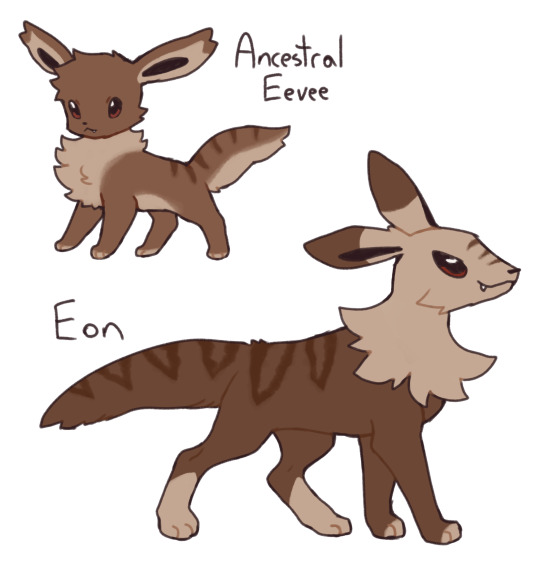
at least until humans came along, anyways. this was ancient civilization, so pokeballs and the concept of pokemon training hadn't really come into existence yet. this made the domestication of eevee all the more interesting; even prior to taming and training pokemon, humans and eevee developed a symbiotic relationship. eevee and eon could do things like hunting for humans and protecting them, and recieve food and protection in return. as years and years passed, eevee and eon became domesticated, and were bred by humans to further suit their needs. as humans spread across the globe, so too did eevee and eon. different groups of people lived in different areas of the world, and so had different needs. this resulted in eon slowly destabilizing and evolving into different varieties, which further diverged and turned into the eeveelutions. it went something like this, each little bubble representing a now-extinct eeveelution that eventually became the modern ones.
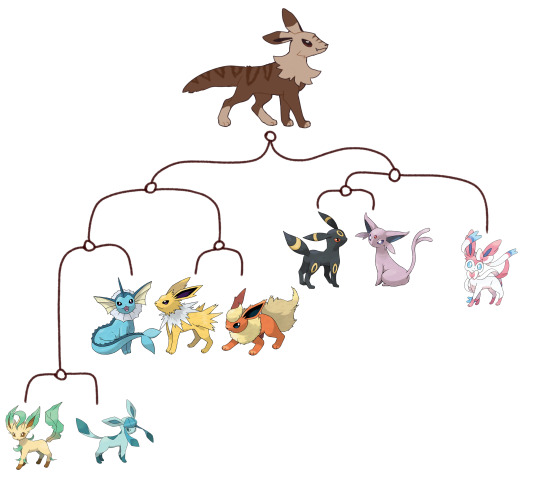
the base evolution, eevee, changed over time but still stayed consistent becauuuuuse idk pokemon science or whatever . you can have a little suspension of disbelief as a treat
anyways if you read all of this: thanks ! it took me hours and i hope it's not too deranged <3
159 notes
·
View notes
Text
Random Fact of the Day
Daily Pokémon that was randomly selected: Aerodactyl!
Did you know that some scholars claim that Mega Aerodactyl is Aerodactyl’s true appearance? Mega Evolution restores some of its dormant genes, bringing back the sharp rocks that once covered this Pokémon’s entire body. The rocks on Mega Aerodactyl’s body are harder than diamonds!
Prior Post about Aerodactyl

27 notes
·
View notes
Photo
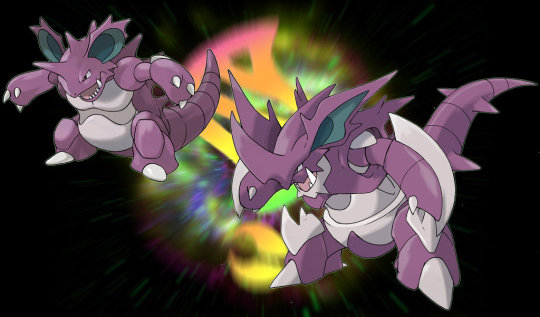


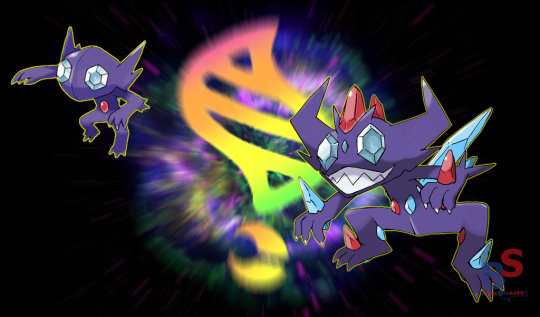


Fan made Pokémon Mega Evolutions!
Check out the artist badafra's Deviantart ★
And more Mega Evolutions ☆
18K notes
·
View notes
Text
Pokémon Gender and Breeding
Pokémon breed very differently in captivity compared to the wild. There are very few documented cases of Pokémon breeding ‘naturally’ in captivity. Instead, two Pokémon combine their life energy to create an egg. This is a very private affair. When breeding in this way, the egg is always the same species as the mother. There have been some cases of two males creating an egg, which is theorised to be how some all-male species reproduce.
Pokémon in the wild mate in much the same way as humans do. In most cases wild Pokémon mate only with their own species, but when they don’t, some of the clutch will usually be one species, while the rest will be another. All-female species tend to override this and will only produce eggs of their kind.
Different species can breed together so long as they are of the same egg group. Ditto are interesting as they can breed with almost any Pokemon, regardless of egg group or gender. Unfortunately, Ditto cannot produce a Ditto egg. It is currently unknown how they reproduce in any context.
Regional starter Pokémon always skew male. This is because breeders catch and raise a high number of female regional starters to keep up with demand. This has happened with a few other species also, namely Eevee. In many areas, this has led to numbers of wild starters and Eevees dwindling dangerously low. Efforts are being made to improve this. It is also much more likely for Pokémon restored from fossils to be male. Researchers are currently unsure if this is because these fossils are better preserved, if the restoration machines alter the sex, or some other reason.
Interestingly, some Pokémon change sex throughout their lives. Approximately 1/3 of female Azurill will evolve into Male Marill, but not the other way around. In rare cases, a female Espurr who has a preference for defence will become a male Meowstic, and a male Espurr with a preference for attack will become a female Meowstic. This is very uncommon and has only been documented a handful of times.
Gender Unknown Pokémon (sometimes referred to as Genderless Pokémon) reproduce in a variety of different ways. Most can combine their life energy with a Ditto to create an egg.
Despite being in the same evolutionary line, Staryu and Starmie reproduce very differently. Staryu reproduces asexually. Beneath their gem, they have a central disk which is pentametric. It drops an arm and 1/5 of this disk, which then grows the rest of its disk, arms, and orb. Only when it is fully grown can it battle. As it is effectively a replica of the original, a shiny Staryu will always produce shiny offspring. Starmie, on the other hand, produce sexually. Starmie do have a sex, though it is impossible to determine without killing it. They interlock with one or more partners and produce via external fertilization. Sometimes the young will attach themselves to their parents until they are properly developed. A shiny Starmie is no more likely to produce a shiny Staryu than a standard Starmie would.
Magneton breed by coming together in a group, much like Starmie. It is believed they combine their lifeforce (in the same way Pokémon can create eggs) into scrap metal and old appliances, and make Magnemite in their image. Magnemite cannot breed without evolving, as the process is too similar to joining up with others. The Klink line do the same with gears.
Voltorb and Electrode reproduce similarly to Magneton. When a group finds an abandoned pokéball (broken or whole), they put their lifeforce into it. This is believed to be why they no longer resemble old-style pokéballs, though theoretically it is possible. They do not appear to be interested in other types of pokéballs.
Groups of Solrock, and Lunatone come together in rocky fields during midday and midnight respectively. They perform an interesting ceremony, at the end of which the rocks become either Solrock or Lunatone.
Watching a Polteageist reproduce is quite interesting. Several Polteageist will gather around a teacup and simply pour into it. Documented cases have found anywhere from a 1 to 33 Polteageist to participate, though most commonly its between 3-7.
Dhelmise put their life force into seaweed and guide them to shipwrecks to merge with the debris.
Many artificial Pokémon simply create more of their kind. This has been documented with Golurk, Claydol, and Porygon.
It is believed that Cryogonal reproduce when melted into water vapour during the summer. Areas that never get warm enough for this tend to have very few Cryogonal, and often require human interference to maintain their populations.
As Tandemous and Maushold are considered a family group, they have been given ‘gender unknown’ status to encompass the whole group, though individually it is very easy to distinguish males and females. Maushold have never been seen reproducing. One day, their young just appear. When their young are big enough to fend for themselves, they will pair up with another and become a Tandemous. Within a day, the parents have more young.
Despite being ‘gender unknown’, Manaphy and Phione reproduce the same as any other Pokémon. It is believed they do have genders. Whether the egg hatches as a Manaphy or a Phione depends on the water temperature.
Research is being done to discover how other gender unknown Pokémon reproduce in the wild.
#pokemon#Pokemon Trainer#Shiny Pokemon#pokedex#pokemon headcanons#pokemon headcannons#golurk#claydol#porygon#cryogonal#tandemous#maushold#manaphy#phione#dhelmise#staryu#starmie#solrock#lunatone#magneton#magnemite#klink#klang#klinklang#polteageist#voltorb#electrode#ditto#azurill#marill
48 notes
·
View notes
Text
In times gone past, travellers crossing the arid regions of Paldea were encouraged to carry supplies of white pebbles with them, as a means of protection against wandering brambleghasts. Such pebbles needed to be small enough to fit in the palm of your hand, and they had to be arranged in a circle around any place where you stopped to rest.
The custom goes that the pebbles, being roughly the same weight and colour as living souls, might trick passing brambleghasts into thinking they had found prey. In turn, they would then ignore the soul of the traveller sleeping inside the circle. This custom is not often practised now, but you will still find rings of pale stones out in remote areas of Paldea. Sometimes, there will be a break in the circle, as though one pebble has been stolen away.
323 notes
·
View notes
Text
Tinkaton are largely solitary creatures, but they will occasionally have peaceful meetings with other conspecifics wherein they trade in scraps of metal or jewels to embellish their hammers. Researchers were stumped for decades on how individuals who were known to have spent their whole lives in a single area would add stones from faraway caves to their collections, until one Ranger happened to witness and film such an exchange. The trade value that Tinkaton place on different gems and minerals remains unclear. Thus far, it seems that some individuals prefer harder, spikier pieces that will help deal more damage when they swing their hammer at foes, whereas others prefer more sparkly or colorful gems for an aesthetic effect.
-Thea
428 notes
·
View notes
Text
It's usually unwise to keep multiple psuedo-legendary Pokémon together as they can get quite territorial. The two big exceptions are Dragonite and Goodra, as their pleasant disposition makes them easier to get along with (of course, this isn't guaranteed). This is particularly true if Dragonite/Goodra is female and the other psuedo is male.
9 notes
·
View notes
Text
The Paldean battle circuit has always had an international presence, oweing largely to the prestige of Naranja Academy and the high volume of budding trainers it accepts from abroad, but the commercialisation of the terastal phenomenon has driven tourism to new heights. Over the last decade, Paldea has become a thriving hub of international competitions and tournaments, one of the most popular draws for professional trainers, amateurs, and spectators outside of the Indigo League.
The invention of Tera Orbs is credited as the reason for this boom. The technology is still in its infancy, so League officials were originally hesitant to incorporate it into Gym and Elite battles, but it created an immediate buzz of excitement both locally and abroad. Once Tera Orbs were reliable enough to be distributed to members of the public - albeit in small numbers, and at great expense - Paldea cemented its place as a new hotspot for battle innovation.
The Paldean League now works in partnership with others across the world, most notably the Indigo and Kalosian Leagues. Their Gym Leaders and Elites are not only invited to open tournaments, but provided with Tera Orbs so that they may terastallize their pokémon during any competitions. Foreign trainers are often fascinated to discover the dormant tera types of their pokémon, and enjoy the new challenges that terastallizing brings to battles; Alder, former Unovan champion, now competes more in Paldea than his home nation. Likewise, long-time fans of established trainers will often travel to see them partake in Paldean tournaments, as the battling in Paldea is unlike anywhere else in the world.
Tera Orbs are currently limited in their range, and lose functionality outside a certain radius of Area Zero. Even in Paldea itself, there are known ‘dead spots’ where the Orbs become significantly less reliable, particularly by the coast or at high altitudes. Using them outside of the region is impossible. There are plans to develop the technology further, increasing the range until terastallising can be introduced to the global stage, but they aren’t without pushback. Many believe that it would drive Paldea back into relative obscurity, because it would dispense with the principal thing that makes their battle circuit unique. In any case, such developments are likely to take decades.
249 notes
·
View notes
Text
Tinkaton line in Galar
Motions to completely ban the Tinkaton line in Galar were not well supported, however the laws surrounding them are very strict.
Trainers must have a specific license to have one, as well as insurance for any damage they may cause. When entering the region (or receiving them via transfer), the trainer must sign an acknowledgement that any damage or injury received due to negligence, or releasing one into the wild can result in prison time. The maximum sentence for releasing one is 10 years. Local law enforcement also must be made aware of their presence. Naturally, Corviknight Taxis have banned them from their services, and any interference with them can result in a trainer losing their license.
#tinkatuff#tinkatink#tinkaton#corviknight#corviknight taxi#Galar#galar region#pokemon#Pokemon Trainer#paldea#pokemon headcanons#pokemon headcannons#pokemon trainer
102 notes
·
View notes
Text
Some Way Too In-depth Headcanons About How Pokeballs Work
Legends Arceus has a line about how Pokeballs function that makes no sense, so I might as well offer my headcanons as a supplementary explanation.

So basically, the game says [paraphrasing] that Pokemon “shrink themselves down” to go into Pokeballs. That’s inherently contradictory with the gameplay; not only should every Pokemon know minimize if this were the case, but it doesn’t explain why a Pokemon goes into a Pokeball only to break out of it, or how they go into a Pokeball after they’re already fainted.
So my take on it is to go at the same idea in a different way. When a Pokemon evolves, it completely changes size and shape, and this is often accompanied by some form of light.
Basically, all Pokemon have the ability to convert themselves into energy/light like this. This is how they evolve, as well as reproduce. It’s not something they can do on command, however; it’s more of a reflex that triggers under specific circumstances. While in the form of energy like this, the amount of space the energy takes up can be condensed or expanded, which is how they change size upon evolving.
All a Pokeball does is provide an artificial trigger for this to occur. A cut and polished tumblestone’s (one of the items needed for crafting Pokeballs) presence automatically causes a Pokemon to revert to this energy form due to a chemical reaction. When the Pokemon comes into contact with a Pokeball, it transforms into energy due to the tumblestone; said energy is pulled towards the stone and condenses down to fit inside the apricorn. Once the Pokemon is in its energy form, it remains in that form in the Pokeball due to the tumblestone’s presence until it’s sent out. Older Pokeballs spit out excess energy from the catch in the form of “fireworks”; newer Pokeballs are more efficient and don’t need to do this.
All Pokemon can reduce their energy forms down to the same size, regardless of how big they are; however, the bigger the ‘mon, the more powerful the energy is when condensed, which makes it easier for them to break out during a catch. Likewise, the more powerful the Pokemon, the more energy needs to be contained. This is why different types of tumblestones are used for different types of Pokeballs, as the variations of the stone have varying degrees of strength.
Because this energy conversion normally happens during key moments in a Pokemon’s life, it gives them a rush of endorphins. This means that a Pokemon instinctively wants to go inside of a Pokeball and curl up there; they find the experience to be cozy. This behavior also helps them conserve energy and heal after a long battle (they don’t feel pain from injuries while in the ball, but they can still become weak and faint).
Modern day Pokeballs are capable of producing simulations for the Pokemon inside, giving them the illusion of being bigger on the inside. The environments vary based on the type of Pokeball used, and different types of environments can increase catch rates; for example, while regular Pokeballs use an open field, lure balls create an underwater environment that’s more appealing to aquatic species.
So Pokemon do possess the ability to shrink themselves down… after converting into energy. And Pokemon do shrink themselves down to go inside of Pokeballs… as an automatic reflex in response to the tumblestone. So nothing the professor says is actually wrong; it’s just oversimplified, probably intentionally to make it easier for the protag to understand.
This is also why humans can’t go into Pokeballs; while descended from Pokemon, human beings lost the ability to evolve and convert into energy years ago. Because the Pokeball requires the subject to be able to do this in order to function, they have no effect on people.
1K notes
·
View notes
Text
“Raichu Had Too Much Pie-chu” is a children’s book similar to The Very Hungry Caterpie, about a chubby Raichu listening off all the food they’ve eaten before they go to bed.
68 notes
·
View notes